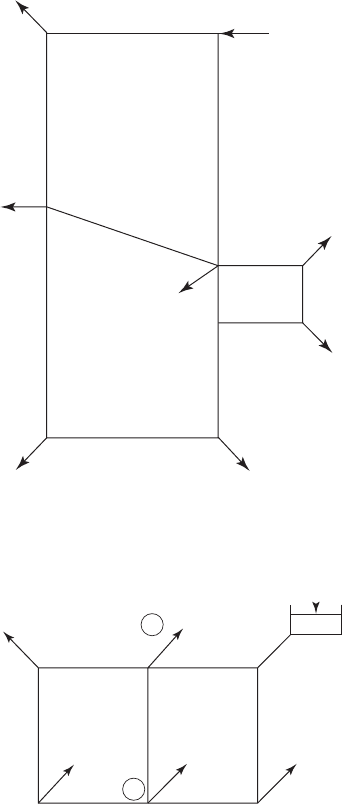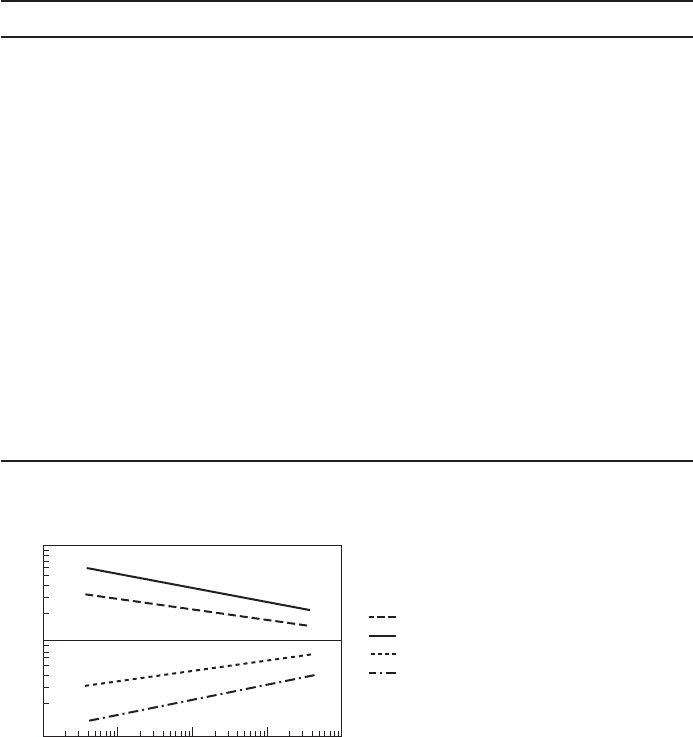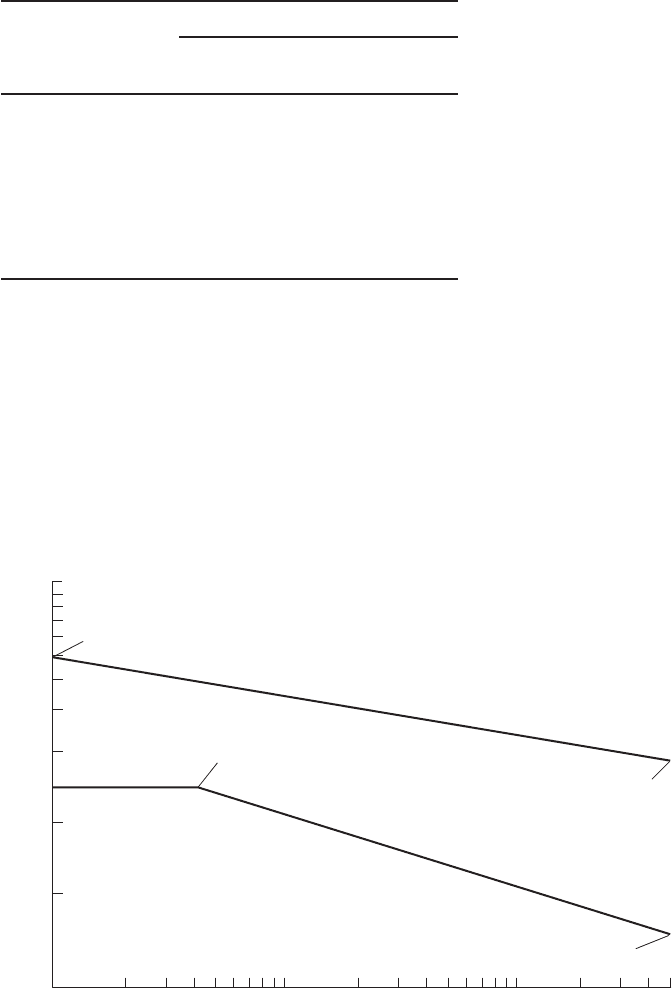Water and Wastewater Engineering
Подождите немного. Документ загружается.


17-50 WATER AND WASTEWATER ENGINEERING
17-11 DISCUSSION QUESTIONS
17-1. The design of a water distribution system requires that the engineer compute a NFF
for each building in the district. True or false? If the answer is false, correct it in a
nontrivial manner.
17-2. Why is a storage tank that is wider than it is tall preferred over a narrow tall tank?
FIGURE P-17-25
Distribution network analysis with fire.
A dapted from Steel and McGhee, 1979.
300 mm
1,000 m
IA
Inflow
300 mm
1,000 m
400 mm
1,250 m
300 mm
1,250 m
300 mm
1,000 m
350 mm
600 m
200 mm
500 m
200 mm
500 m
200 mm
400 m
350 mm
400 m
2
5
0
mm
1,00
0
m
D
C
B
E
25 m
3
/min
2.2 m
3
/min
2.5 m
3
/min
14 m
3
/min
2.3 m
3
/min
1.5 m
3
/min
2.0 m
3
/min
0.5 m
3
/min
H
G F
I
II
III
FIGURE P-17-26
Distribution network analysis with elevated storage.
A dapted from Steel and McGhee, 1979.
400 mm
2,000 m
300 mm
350 mm
200 mm
250 m
–300 m
2,000 m
15 m
3
/min
5 m
3
/min
5 m
3
/min 10 m
3
/min
5 m
3
/min
A
B
200 mm
2,000 m
400 mm
2,000 m
3
00
mm
150
m
200 mm 1,000 m1,000 m 1,000 m
STORAGE AND DISTRIBUTION SYSTEMS 17-51
17-3. You have been asked to enter a water storage tank to complete an inspection punch
list after construction because you have had confined space training. The work crew
is swabbing the interior with 200 mg/L of chlorine. The following personal protective
equipment (PPE) has been provided. Is anything missing or incorrect?
a . Hard hat
b . Work boots
c. Prote
ctive coveralls
17-12 REFERENCES
AWWA (1998) Distribution System Requirements for Fire Protection, Manual M31, American Water
Works Association, Denver, Colorado.
AWWA (2003) Ductile-Iron Pipe and Fittings, Manual M41, American Water Works Association, Denver,
Colorado.
AWWA (2006) Distribution Valves: Selection, Installation, Field Testing, and Maintenance, Manual 44,
American Water Works Association, Denver, Colorado.
Bosserman, B. E. (2000) “P
ump System Hydraulic Design,” in L. W. Mays (ed.), Water Distribution
Systems Handbook, McGraw-Hill, New York, pp. 5.1–5.40.
Clark, R. M., W. M. Grayman, R. M. Males, and A. F. Hess (1993) “Modeling Contaminant Propagation in
Drinking Water Distribution Systems,” Journal of Environmental Engineering, vol. 119, no. 2,
pp. 349–361.
Coté, A. E. and J. L. Linville (eds.) (1997) Fire Protection Handbook, 18th ed., National Fire Protection
Association, Quincy, Massachusetts.
Dixon Engineering Inc. (2008) Dixon Digest, Lake Odessa, Michigan.
GLUMRB (2003) Recommended Standards for Water Works, Great Lakes–Upper Mississippi River
Board of State and Provincial Public Health and Environmental Managers, Health Education
Services, Albany, New york, pp. 103–118.
Grayman, W. M., L. A. Rossman, R. A. Deininger, C. Smith, C. N. Arnold and J. F. Smith (2004)
“Mixing and Aging of Water in Distribution System Storage Facilities,”
Journal of American Water
Works Association, vol. 96, no. 9, pp. 70–80.
Haas, C. N, M. Gupta, R. Chitluru, and G. Burlingame (2002) “Chlorine Demand in Disinfecting Water
Mains,” Journal of American Water Works Association, vol. 94, no. 1, pp. 97–102.
Honeycutt, F. G. and D. E. Clopton (1976) “Water Supply,” in I. J. Karassik, W.C. Krutzsch, W. H.
Fraser, and J. P. Messina (eds.) Pump Handbook, McGraw-Hill, New York, pp.10-6–10-13.
Kirmeyer, G. K., L. Kirby, B. M. Murphy, P. F. Noran et al. (1999) Ma
intaining Water Quality in Finished
Water Storage Facilities, A merica Water Works Association Research Foundation, Denver, Colorado.
Linaweaver, F. P., J. C. Geyer, and J. B. Wolff (1967) “Summary Report on the Residential Water Use
Research Project,” Journal of the American Water Works Association, vol. 59, p. 267.
Moser, A.P. (ed.) (2001) Buried Pipe Design, 2nd ed., McGraw-Hill, New York.
NFPA (1987) Standard for the Installation of Sprinkler Systems, National Fire Protection Association,
Standard No. NFPA 13-1987, Quincy, Massachusetts.
Rossman, L. A. (2000) “Computer Models/EPANET,” in L.W. Mays (ed.), Water Distribution Systems
Handbook, McGraw-Hill, New York, pp. 12.1–12.23.
Sanks, R. L. (2006) “Data for Flow in Pipes, Fittings, and Valves,” in G. M. Jones (ed.), Pump Station
Design, Elsevier, New York, p. B11.
Steel, E. W. and T. J. McGhee (1979) Water Supply and Sewerrage, 5th e
d., McGraw-Hill, New York,
pp. 124, 151.
U.S. PHS (1963) Water Supply and Plumbing Cross-connections, U.S. Department of Health Education
and Welfare, Public Health Service, Washington, D.C., p. 30.
17-52 WATER AND WASTEWATER ENGINEERING
Walski, T. M. (2000a) “Water-Quality Aspects of Construction and Operation,” in L.W. Mays (ed.) Water
Distribution Systems Handbook, McGraw-Hill, New York, pp. 8.1–8.11.
Walski, T. M. (2000b) “Hydraulic Design of Water Distribution Storage Tanks,” in L.W. Mays (ed.),
Water Distribution Systems Handbook, McGraw-Hill, New York, pp. 10.1–10.20.
Y susi, M. A. (2000) “System Design: Overview,” in L.W. Mays (ed.), Water Distribution Systems
Handbook, McGraw-Hill, New York, pp. 3.1–3.49.

18-1
18-6 PLANT LOCATION
18-7 CHAPTER REVIEW
18-8 PROBLEMS
18-9 DISCUSSION QUESTIONS
18-10 REFERENCES
GENERAL WASTEWATER COLLECTION AND
TREATMENT DESIGN CONSIDERATIONS
18-1 WASTEWATER SOURCES AND FLOW
RATES
18-2 WASTEWATER CHARACTERISTICS
18-3 WASTEWATER TREATMENT STANDARDS
18-4 SLUDGE DISPOSAL REGULATIONS
18-5 PLANT SIZING AND LAYOUT
18
CHAPTER

18-2 WATER AND WASTEWATER ENGINEERING
18-1 WASTEWATER SOURCES AND FLOW RATES
Like with water supply design, a fundamental prerequisite to begin the design of wastewater
facilities is a determination of the design capacity. This , in turn, is a function of the wastewater
flow rates. The determination of wastewater flow rates consists of five parts: (1) selection of a
design period, (2) estimation of the population and comm
ercial and industrial growth, (3) esti-
mation of wastewater flows, (4) estimation of infiltration and inflow, and (5) estimation of the
variability of the wastewater flow rates.
Design Period
The constraints in selecting a design period (design life) are very similar to those d iscussed at
length in Chapter 2 and will not be repeated here. Design periods that are commonly employed in
practice and commonly experienced life expectancies are shown in Table 18-1 .
Components of Wastewater
Wastewater may be classified into the following components:
• Domestic or sanitary wastewater. Wastewater discharged from res idences, commer-
cial (e.g., banks, restaurants, retail stores), and institutional facilities (e.g., schools and
hospitals).
• Industrial wastewater. Wastewater discharged from ind
ustries (e.g., manufacturing and
chemical processes).
• Infiltration and inflow (I/I). Water that enters the sewer system from groundwater infiltra-
tion and storm water that enters from roof drains, foundation d rains , and submerged man-
holes.
• Storm water. Runoff from rainfall and snow melt.
Type of facility Characteristics
Design
period, y
Life
expectancy, y
Treatment plants
Fixed facilities Difficult and expensive to
enlarge/replace
20–2550
Equipment Easy to refurbish/replace 10–15 10–20
Collection systems
Trunk lines and interceptors
60 cm
Replacement is expensive
and
difficult
20–25 60
Laterals and mains 30cm Easy to refurbish/replace
To full development
a
40–50
TABLE 18-1
Design periods for wastewater works
a
Full development (also called “build-out”) means that the land area being serviced is completely occupied by houses and/or
commercial and institutional facilities.
GENERAL WASTEWATER COLLECTION AND TREATMENT DESIGN CONSIDERATIONS 18-3
Domestic Wastewater Flows
Residential Districts. When the proposed project is in a community with an existing wastewa-
ter collection system, the community’s historic records provide the best estimate of wastewater
production. Conversion of total wastewater flow to a per capita basis allows for the separation of
population growth from the growth in unit production of wastewater. In the absence of existing
data for the
client community, installation of temporary flow meters or nearby communities with
similar demographics are good alternative sources of data. When the demographics differ in some
particular aspect such as a higher or lower density of commercial facilities or a major industrial
com
ponent, adjustment in the total wastewater production will be appropriate. Gross estimates of
unit demand may be made using statewide data. Hutson et al. (2001) have estimated water use by
state, and the United States Bureau of Census (Census, 2006) maintains a population database by
state. Great care shou
ld be used in making estimates from generalized data. All the water with-
drawn for use does not end up in the sewer. A rough estimate of 60 to 90 percent of the domestic
water-withdrawal rate may be used to estimate the production of residential wastewater. The
higher percentages apply to northern states in cold weather. In warm, dry c
limates where water
is used for evaporative cooling of homes and landscape irrigation, the lower percentage is more
likely (Metcalf & Eddy, 2003).
GLUMRB (2004) recommends that the sizing of facilities receiving flows from new waste-
water collection systems be based on an average domestic daily flow of 380 liters per capita per
day (Lpcd) plus wastewater flow
s from commercial, institutional, and industrial facilities.
Regulations requiring the use of water s aving devices (Table 2-5) can significantly reduce
the wastewater flow.
Commercial Districts and Institutional Facilities. Estimates for commercial wastewater
flows range from 7.5 to 14 m
3
/ha · d (cubic meters per hectare per day)(Metcalf & Eddy, 2003).
For small districts with a limited number of well-defined businesses and institutions, Tables 2-2
and 2-3 in Chapter 2 can provide a basis for estimating commercial and institutional flows.
Industrial Wastewater Flows
If the water requirements of the industries are known, estimates of wastewater flow may be made
by assuming about 85 to 95 percent of the water used becomes wastewater when internal recycle
is not practiced. A typical design value for estimating the flows from industrial districts that have
few wet proce
sses is in the range 7.5 to 14 m
3
/ha · d for light industrial development and 14 to
28 m
3
/ha · d for medium industrial development (Metcalf & Eddy, 2003).
To reduce charges for wastewater, many industries have implemented water conservation
programs. These programs may result in significant redu ctions from typical values. Special
investigation of industrial sou
rces to obtain realistic estimates is warranted.
Infiltration and Inflow
The extraneous flows in sewers are defined as follows (Federal Register, 1974):
• Infiltration. The water entering a sewer system, including sewer service connections and
from the ground through foundation drains, defective pipes, pipe joints , connections, or
manhole walls. Infiltration does not includ
e inflow.
18-4 WATER AND WASTEWATER ENGINEERING
• Inflow. The water discharged into a sewer system, including service connections from
such sources as roof downspouts (also called leaders ); basement, yard, and area
drains; cooling-water discharges; drains from springs and swampy
areas; manhole
covers; cross connections from storm sewers and combined sewers; catch basins;
storm water; surface runoff; street wash water; or drainage. This category is further
subdivid ed as:
• Steady inflow. This c ategory inclu
des water from basement and footing drains, cooling
water discharges, and drains from springs and swampy areas. It is not distinguis hable
from infiltration when hydraulic measurements are taken in the sewer.
• Direct inflow. These are inflows that c ause an almost immediate in
crease in waste-
water flows. Sources of direct inflow include roof downspouts; basement, yard, and
area drains; footing drains; manhole covers; cross connections from storm sewers and
combined s ewers; catch basins; storm water;
surface runoff; street wash water; or
drainage.
Storm Water
Historically, many communities elected to collect storm water and was tewater in combined
sewers and convey the peak dry weather flow to the wastewater treatment plant while large
surges of storm water were diverted directly to surface water bodies. The resulting mixture of
sewage and storm water has m
ajor adverse impacts on the receiving bodies of water. Current
regulations prohibit this combination in new facilities.
The estimation of storm water flows and the treatment of storm water is a major subject that
is beyond the scope of this text.
Variability of Wastewater Flow Rates
Wastewater flow rates vary over several time scales ranging from diurnal to the design period.
The use of these data in design and operation of the collection system and treatment plant are
outlined in Table 18-2 .
Variation of Domestic Wastewater Flows
Water consumption and wastewater production change with the seasons, the days of the week,
and the hours of the day. Fluctuations are greater in small communities than in large communi-
ties, and during short rather than long periods of time. The variation in wastewater flow rate is
normally reported as a factor of the average day. As noted above, when the proposed
project is
in a community with an existing community wastewater collection and treatment system, the
community’s historic records provide the best estimate of wastewater production. This includes
its variability. Figure 2-1 in Chapter 2 and Figure 18-1 provide alternative methods of es
timating
the variability.
Variation of Commercial, Institutional, and Industrial Wastewater Flows
If the commercial, institutional, and indus trial wastewater flows make up a significant portion
of the average flows (i.e., 2 5 percent excluding infiltration), peaking factors for each category
should be estimated separately.

GENERAL WASTEWATER COLLECTION AND TREATMENT DESIGN CONSIDERATIONS 18-5
Flow rate Use in design and operation
Average daily Base for development of flow rate ratios and for
estimating pumping, sludge quantities, and chemical
costs; identification of sewers where flows will not
achieve minimum velocities
Minimum hour
Estimating turndown ratio
a
for pumping facilities
and low range for plant flow metering
Minimum day Sizing of plant components (influent channels,
biological treatment systems including recycle
requirements for trickling filters)
Minimum month Selection of minimum operating units required
during low flow periods (especially at start-up of new
fac
ility); scheduling shutdown for maintenance
Peak hour Sizing of sanitary sewers; sizing pumping facilities
and channels; sizing of physical unit operations
including bar racks and screens, grit chambers,
sedimentation tanks, filters, and chlorine contact tanks
Maximu
m day Sizing equalization basins and sludge pumping systems
Maximum month Sizing chemical storage facilities
TABLE 18-2
Principal flow rate terms and their use in design and operation
a
The ratio of the highest operating flow rate to the lowest operating flow rate.
A dapted from Metcalf & Eddy, 2003.
Variation of Infiltration Flows
The amount of groundwater flowing from a given area varies from a negligible amount for
a highly impervious area to 25 to 30 percent of the rainfall for a pervious area with a sandy
subsoil. The infiltration of groundwater into the sewer may range from 0.01 to more than
1.0 m
3
/ d · mm · km (cubic meters per day per mm diameter of sewer per km length of sewer).
For existing s ewer systems, flow measurement provides the best estimate of infiltration/
inflow. Metcalf & Eddy (1981) provides a detailed discussion of these techniques. For new
sewers, average rates from si
milar existing sewers, corrected for differences in m aterials, con-
struction methods, and antic ipated future conditions provide another source of data.
0.1
10
100 1,000 10,000 100,000 1,000,000
Average daily flow rate, m
3
/d
Ratio to average daily flow
Minimum day
Maximum day
Peak hour on max. day
Minimum hour on min. day
1
FIGURE 18-1
Ratio of extreme flows to average daily flow.

18-6 WATER AND WASTEWATER ENGINEERING
In the absence of actual measurements, past practice and regulatory agency requirements,
such as those shown in Table 18-3 , may be considered as a basis for an estimation (ASCE, 1982).
Alternatively, Figure 18-2 may serve as a means of estimating peak infiltration flows. These c
urves
may be considered conservative for most sewer designs. The category of “new sewers” includes
those recently constructed in which precast concrete manholes were used and in which pipe joints
were sealed with compression gasket
s or rubber or rubber-like materials (Metcalf & Eddy, 1981).
Based on examination of 20 data sets from the midwestern and central United States, Lyon
and Nelson (2002) found that the average dry weather flow allowance of 380 Lpcd needs to be
increased to better account for actual infiltration. For small tributary systems (6,000 m
3
/ d)
100
50
40
30
20
10
5
2
10
50
100
500 1,000
5,000
Service area, ha
a
New sewers include existing sewers having pipe joints
sealed with compression gaskets of elastomeric materials.
Peak infiltration rate, m
3
/ha
.
d
5,000 ha, 3.3 m
3
/ha
.
d
5,000 ha, 10.0 m
3
/ha
.
d
40.5 ha, 14.0 m
3
/ha
.
d
10 ha, 48.5 m
3
/ha
.
d
Curve B
for
new sewers
a
Curve A
for
old sewers
FIGURE 18-2
Peak infiltration allowances. Source: Metcalf & Eddy, 1981.
Infiltration Permitted
Pipe diameter,
mm m
3
/d · km L/d · mm · km
Regulations prior to 1980
200 8 to 12 40 to 60
300 10.5 to 13.5 35 to 40
600 24 to 27 40 to 45
New pipe
10 to 40
TABLE 18-3
Typical infiltration allowances
A dapted from ASCE, 1982.

GENERAL WASTEWATER COLLECTION AND TREATMENT DESIGN CONSIDERATIONS 18-7
the peaking factors in Figures 2-1 and 18-1 are not conservative enough. Based on the Lyon and
Nelson (2002) data, an average dry weather flow allowance of 440 to 500 Lpcd appears to be
more appropriate. For very small, extremely leaky sanitary sewer systems, a peaking factor as
high as 15 is possible. Very leaky systems m ay have a peaking factor as high as
10. Moderately
leaky systems may have a peaking factor as high as 5.
18-2 WASTEWATER CHARACTERISTICS
Characteristics of Domestic Wastewater
Physical Characteristics of Domestic Wastewater. Fresh, aerobic, domestic wastewater has
been said to have the odor of kerosene or freshly turned earth. Aged, septic sewage is consider-
ably more offensive to the olfactory nerves. The characteristic rotten-egg odor of hydrogen sul-
fide and the mercaptans is indicative of septic
sewage. Fresh sewage is typically gray in color.
Septic sewage is black.
Wastewater temperatures normally range between 10C and 20 C. In general, the tempera-
ture of the wastewater will be higher than that of the water supply. This is because of the addition
of warm water from households and heating within the plumbing system of the structures.
One
cubic meter of wastewater weighs approximately 1,000,000 grams. It will contain about
500 grams of solids. One-half of the solids will be dissolved solids such as calcium and sodium
salts as well as and soluble organic compounds. The remaining 250 grams will be insoluble. The
insoluble fraction consists of about 125 grams of material that will settle out of the liquid fraction
in 30 minutes under quiescent conditions. The remaining 125 grams will remain in suspension for
a very long time. The result is that wastewater is highly turbid.
Chemical Characteristics of Domestic Wastewater. Because the number of
chemical com-
pounds found in wastewater is almost limitless, we normally restrict our consideration to a few
general classes of compounds. These classes often are better known by the name of the analytical
procedure used to measure them than by what is inc
luded in the class. The biochemical oxy-
gen demand (BOD
5
) test is a case in point. Another closely related test is the chemical oxygen
demand (COD) test.
The COD test is used to determine the oxygen equivalent of the organic matter that can be
oxidized by a strong chemical oxidizing agent (potassium dichromate) in an acid medium. The COD
of a waste, in general, will be greater than the BOD
5
because more compounds can be oxidized
chemically than can be oxidized biologically and because BOD
5
does not equal ultimate BOD.
The COD test can be conducted in about three hours. If it can be correlated with BOD
5
, it can
be used to aid in the operation and control of the wastewater treatment plant (WWTP).
Total Kjeldahl nitrogen (TKN) is a measure of the total organic and ammonia nitrogen in the
wastewater. * T KN gives a measure of the availability of nitrogen for building microbial cells, as
well as the potential nitrogenous oxygen demand that will have to be satisfied.
Phosphorus may appear in m
any forms in wastewater. Among the forms found are the
orthophosphates, polyphosphates, and organic phosphate. Together, these are referred to as “total
phosphorus (as P)”.
The broad categories of BOD, COD, TKN, and suspended solids are divided into subcategories.
The current nomenclature used to characterize wa
stewater constituents used in the design of bio-
logical wastewater treatment processes and their shorthand designations are shown in Table 18-4 .
* Pronounced “kell dall” after J. Kjeldahl, who developed the test in 1883.
